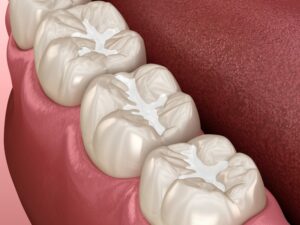
When it comes to preventing cavities, brushing and flossing are essential, but there’s another powerful tool in the fight against tooth decay: dental sealants. These thin, protective coatings are often recommended for children, but adults can benefit from them too. Still, many people have questions about what sealants are, how they work, and whether they’re necessary. Here are answers to 6 of the most common questions about dental sealants to help you decide if they’re right for you or your child.
1. What Are Dental Sealants?
Dental sealants are thin, plastic coatings applied to the chewing surfaces of the back teeth, usually the molars and premolars. These areas are filled with grooves and pits where food particles and bacteria can easily get trapped, making them a prime spot for cavities.
Sealants create a smooth, protective barrier that keeps food and plaque from settling into those hard-to-clean areas, reducing the risk of tooth decay.
2. Who Should Get Dental Sealants?
Sealants are most commonly applied to children and teenagers, particularly once their permanent molars come in, typically around ages 6 and 12. However, adults can also benefit from sealants, especially if they have deep grooves in their teeth or are prone to cavities.
Your dentist may recommend sealants if:
- You or your child have had cavities in the past.
- The molars have deep pits that are hard to clean.
- You want an extra layer of protection for your oral health.
3. How Are Sealants Applied?
Getting dental sealants is a quick, painless procedure that usually takes just a few minutes per tooth. First, the tooth is cleaned and dried. A special gel is applied to roughen the surface, helping the sealant bond properly. Then, the tooth is rinsed and dried again before the liquid sealant is painted on and hardened using a curing light.
There’s no drilling, no numbing, and no discomfort involved.
4. How Long Do Sealants Last?
Dental sealants can last 5 to 10 years or more, but they aren’t permanent. They can wear down over time, especially with chewing and grinding. During routine dental visits, your dentist will check the sealants for wear and can reapply them if necessary.
5. Are Dental Sealants Safe?
Yes, dental sealants are considered very safe. Some people express concern about BPA (bisphenol A), a compound found in many plastics. However, the amount of BPA in dental sealants is extremely low, far below the levels that pose any health risk. According to the American Dental Association, the benefits of sealants far outweigh any potential risks.
6. Do Sealants Replace Brushing and Flossing?
Not at all. Sealants are a helpful supplement to good oral hygiene, not a substitute. You’ll still need to brush twice a day, floss daily, and see your dentist regularly to keep your teeth healthy.
Dental sealants are a simple yet powerful way to protect teeth, especially for children and teens. By filling in deep grooves and preventing food and bacteria from settling in, sealants help reduce the risk of cavities and make daily brushing more effective. If you’re curious about whether sealants are right for you or your child, talk to your dentist at your next appointment.
About the Author
Dr. Linda Steele has been practicing dentistry for nearly 30 years. After graduating from the Baylor College of Dentistry, she completed a pediatric residency at Children’s Mercy Hospital in Kansas City. Dr. Steele stays current in her field through professional memberships in the American Dental Association, the Texas Dental Association, and the American Academy of Pediatric Dentistry. If you or your child need dental sealants in the fight against tooth decay, schedule your appointment online or call (972) 315-3355.

